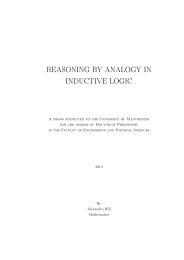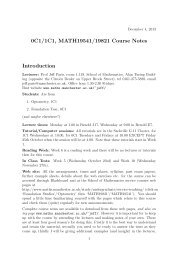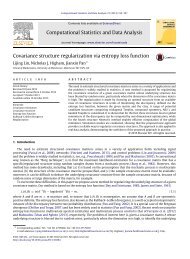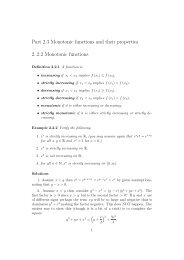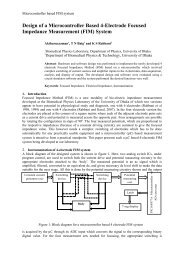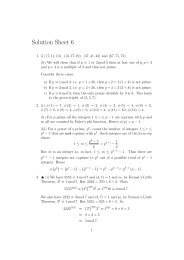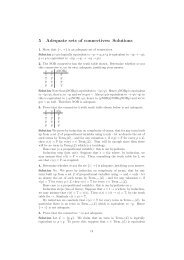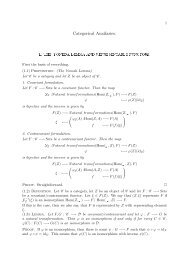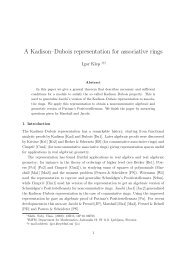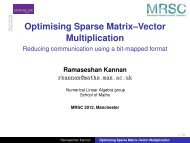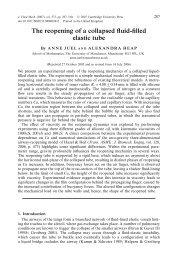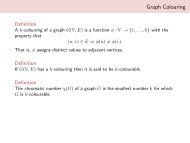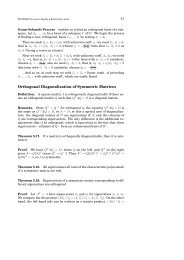Prospettive logiche sul ragionamento incerto in intelligenza artificiale
Prospettive logiche sul ragionamento incerto in intelligenza artificiale
Prospettive logiche sul ragionamento incerto in intelligenza artificiale
Create successful ePaper yourself
Turn your PDF publications into a flip-book with our unique Google optimized e-Paper software.
<strong>Prospettive</strong> <strong>logiche</strong> <strong>sul</strong> <strong>ragionamento</strong> <strong><strong>in</strong>certo</strong> <strong>in</strong><br />
<strong>in</strong>telligenza <strong>artificiale</strong><br />
(lavori <strong>in</strong> corso!!!)<br />
H. Hosni<br />
hykel@maths.man.ac.uk,<br />
12 novembre 2003<br />
1 Un po’ di coord<strong>in</strong>ate<br />
1.1 Intelligenza <strong>artificiale</strong><br />
Per com<strong>in</strong>ciare: [McC96]<br />
In via del tutto generale si possono <strong>in</strong>dividuare due scopi pr<strong>in</strong>cipali dell’<strong>in</strong>dag<strong>in</strong>e<br />
<strong>in</strong> IA: la spiegazione del “comportamento <strong>in</strong>telligente” e la sua<br />
implementazione <strong>in</strong> sistemi computazionali.<br />
Sebbene non sia ragionevolmente possibile fornire una caratterizzazione<br />
univoca del dom<strong>in</strong>io di <strong>in</strong>dag<strong>in</strong>e dell’IA, può essere utile, <strong>in</strong> via del tutto<br />
approssimativa, elencare alcuni dei suoi ambiti pr<strong>in</strong>cipali di ricerca.<br />
IA logica Caratterizzata dall’uso della logica matematica come strumento<br />
metodologico e al tempo stesso strumento di <strong>in</strong>dag<strong>in</strong>e pr<strong>in</strong>cipale.<br />
Uno degli obiettivi di questo filone di ricerca consiste nel fornire una<br />
caratterizzazione formale (logica) del “comportamento <strong>in</strong>telligente”.<br />
IA cognitiva Rivolta pr<strong>in</strong>cipalmente alla spiegazione del comportamento<br />
<strong>in</strong>telligente osservato negli esseri umani e negli animali. La spiegazione<br />
fornita è qu<strong>in</strong>di algoritmica.<br />
IA robotica Pr<strong>in</strong>cipalmente <strong>in</strong>centrata nella realizzazione fisica di agenti<br />
<strong>in</strong>telligenti costituisce l’ambito meno omogeneo, e qu<strong>in</strong>di immediatamente<br />
caratterizzabile, sia per strumenti, sia per metodologia.<br />
Come si ha modo di notare, ogni ambito è connesso all’ambito immediatamente<br />
adiacente ma, nello schema precedente, l’IA logica non non è<br />
necessariamente connessa a quella robotica né per scopi, né per metodologia.<br />
1
1.1.1 Indicazioni bibliografiche generali<br />
Tre manuali classici: [RN95, Nil98, PMG98]. Con la possibile eccezione<br />
del primo, <strong>in</strong> questi manuali vengono trattati tutti gli aspetti <strong>in</strong>dicati nello<br />
schema precedente.<br />
2 Ragionamento <strong><strong>in</strong>certo</strong> <strong>in</strong> IA<br />
La centralità del <strong>ragionamento</strong> <strong><strong>in</strong>certo</strong> <strong>in</strong> IA è diretta conseguenza delle limitazioni<br />
che caratterizzano tutti gli agenti f<strong>in</strong>iti <strong>in</strong> term<strong>in</strong>i di capacità computazionale<br />
(e qu<strong>in</strong>di memorizzazione e estrazione di <strong>in</strong>formazione) e capacità<br />
di disporre di “<strong>in</strong>formazione perfetta”, cioè completa, precisa, consistente.<br />
Alcuni aspetti della seconda limitazione dipendono <strong>in</strong> modo significativo dall’ambiente<br />
<strong>in</strong> cui operano gli agenti. Nel caso di ambienti realistici, si può<br />
ragionevolmente assumere che l’<strong>in</strong>formazione a disposizione degli agenti sia<br />
<strong>in</strong>evitabilmente imperfetta.<br />
Esistono molti approcci logico-matematici al problema, ognuno dei quali<br />
tende alla formalizzazione di una delle caratteristiche che pregiudicano la<br />
perfezione dell’<strong>in</strong>formazione e, di conseguenza, la certezza –<strong>in</strong>tesa come, p.e.<br />
grado “razionale” di conv<strong>in</strong>zione– delle <strong>in</strong>ferenze. Per facilità di esposizione<br />
si possono dist<strong>in</strong>guere (<strong>in</strong> modo assolutamente non esclusivo né esaustivo)<br />
impostazioni non-monotoniche e probabilistiche da un lato e imposazioni<br />
basate su sematiche a “mondi possibili” e polivalenti dall’altro. Le ultime<br />
si dist<strong>in</strong>guono dai sistemi logici non-monotonici e probabilistici nella misura<br />
<strong>in</strong> cui, pur generalizzando il <strong>ragionamento</strong> classico -bivalente e monotoniconon<br />
sono direttamente <strong>in</strong>centrate <strong>sul</strong>la caratterizzazione formale del comportamento/<strong>ragionamento</strong><br />
<strong>in</strong>telligente. Questa nota è fortemente sbilanciata<br />
verso la mia area di ricerca, ovvero la caratterizzazione matematica del<br />
“comportamento <strong>in</strong>telligente”.<br />
Nei term<strong>in</strong>i della suddivisione qui proposta, è <strong>in</strong>teressante notare come il<br />
fenomeno di imperfezione dell’<strong>in</strong>formazione che viene attaccato dalle <strong>logiche</strong><br />
nonmonotoniche e probabilistiche (e il plurale è irriducibile <strong>in</strong> entrambe<br />
le aree) consiste nell’<strong>in</strong>completezza. Si assume, cioè che gli agenti si trov<strong>in</strong>o<br />
costantemente nell’impossibilità di possedere <strong>in</strong>formazioni sufficienti<br />
per la determ<strong>in</strong>azione univoca e “certa” della chiusura logica (nel senso<br />
Tarskiano, qu<strong>in</strong>di, classica) della propria “base di conoscenza”. Nel caso<br />
delle <strong>logiche</strong> polivalenti, per esempio, questa non è un’assunzione necessaria,<br />
poichè il fenomeno largamente preso <strong>in</strong> considerazione è, per quanto<br />
riguarda <strong>logiche</strong> con <strong>in</strong>f<strong>in</strong>iti valori di verità, quello dell’<strong>in</strong>tr<strong>in</strong>seca granularità<br />
2
dell’<strong>in</strong>formazione. Ma logica di Lukasiewicz, per esempio, è classicamente<br />
monotonica.<br />
2.0.2 Indicazioni bibliografiche generali<br />
Una raccolta, datata ma abbastanza generale è [SP90]. Più recente e di<br />
livello più avanzato sono i manuali [GS98a, GS98b, GS98c]. Recentissimo<br />
e generale, soprattutto per quanto riguarda la trattazione di impostazioni<br />
<strong>logiche</strong> probabilistiche e non è il manuale [Hal03].<br />
(Sui vari tipi di imperfezione nell’<strong>in</strong>formazione e la loro relazione con<br />
i rispettivi sistemi logici vedi la sezione 4 di [Hos03] e i riferimenti bibliografici<br />
lì contenuti mentre per un’analisi più approfondita <strong>sul</strong>la relazione<br />
tra “razionalità”, “<strong>in</strong>certezza” <strong>in</strong> <strong>in</strong>telligenza <strong>artificiale</strong> si veda la sezione 2<br />
di [Hos02].)<br />
2.1 Ragionamento non-monotonico<br />
Per com<strong>in</strong>ciare: [LM92]<br />
Some say [GW03] that nonmonotonic logic begun with Aristotle. There<br />
is little doubt, however, that nowadays underp<strong>in</strong>n<strong>in</strong>g the <strong>in</strong>terest <strong>in</strong> this subject<br />
is logic-based artificial <strong>in</strong>telligence. The special issue of Artificial Intelligence,<br />
edited by D.G. Bobrow [Bob80] <strong>in</strong> 1980, constitutes for many respects<br />
the start<strong>in</strong>g po<strong>in</strong>t of a new logico-mathematical field of research. The ma<strong>in</strong><br />
motivation for such an undertak<strong>in</strong>g can be summed up very roughly as the<br />
<strong>in</strong>tention to characterize logical (not necessarily probabilistic) systems capable<br />
of represent<strong>in</strong>g flexible as well as plausible forms of reason<strong>in</strong>g. Reiter’s<br />
Default Logic, [Rei80, RC81], McCarthy’s Circumscription [McC80, McC90]<br />
and McDermott and Doyle’s Non-monotonic Logic [MD80] were but a few<br />
<strong>in</strong>itial attempts to br<strong>in</strong>g about such an ambitious aim. Among them, particular<br />
attention was received by Reiter’s proposal which provided formal<br />
constructions for extend<strong>in</strong>g agents’ knowledge bases beyond the rigidity of<br />
classical monotonic logic, hence allow<strong>in</strong>g flexible, exception tolerant, patterns<br />
of reason<strong>in</strong>g to be represented logically. 1<br />
Those <strong>in</strong>itial proposals focussed essentially on the problem of characteriz<strong>in</strong>g<br />
flexibility <strong>in</strong> reason<strong>in</strong>g. The sem<strong>in</strong>al papers by Gabbay [Gab85], Mak<strong>in</strong>-<br />
1 Indeed Reiter’s logic was developed and then widely appreciated <strong>in</strong> the theory of<br />
databases, especially <strong>in</strong> connection with the so-called Closed World assumption that allowed<br />
agents to “jump to conclusions” that nonetheless could have been subsequently<br />
withdrawn on the addition of new <strong>in</strong>formation. On the “success of default logic” see<br />
[Lif99].<br />
3
son [Mak89] and Kraus, Lehmann and Magidor [KLM90] put the <strong>in</strong>vestigations<br />
on nonmonotonic logics <strong>in</strong>to a more abstract framework –developed at<br />
the traditional levels of proof-theory and model-theory– with the <strong>in</strong>tention of<br />
provid<strong>in</strong>g a clear account of the logical properties of nonmonotonic <strong>in</strong>ference.<br />
From this new, abstract, perspective, the question of plausibility of reason<strong>in</strong>g<br />
could be tackled <strong>in</strong> a more direct way. By study<strong>in</strong>g, <strong>in</strong> fact, consequence<br />
relations it becomes possible to devise appropriate rules which are meant<br />
to capture the conditions that sensible patterns reason<strong>in</strong>g under imperfect<br />
<strong>in</strong>formation should reasonably satisfy.<br />
2.2 Basic concepts and notation<br />
Let SL be the set of sentences built up from a classical propositional language<br />
L <strong>in</strong> the usual way. We use small Greek letters for elements of SL and block<br />
capital Greek letters for subsets of SL. We denote by 2 L the set of classical<br />
valuations on L, that is the set of all maps from L to 2 = {0, 1}. Valuations<br />
extend uniquely to SL <strong>in</strong> the usual, recursive way. We write, as usual, Cn<br />
for the classical consequence operation (sometimes called Tarskian), that is<br />
to say an operation which is reflexive, transitive and monotonic, the correspond<strong>in</strong>g<br />
notation for the classical consequence relation be<strong>in</strong>g ⊢. As we will<br />
only consider f<strong>in</strong>itary consequence (i.e. with premises be<strong>in</strong>g f<strong>in</strong>ite sets of SL)<br />
we’ll adopt the usual convention <strong>in</strong> the area of freely swapp<strong>in</strong>g the notions<br />
of consequence operation and consequence relations. 2<br />
Consequence relations on 2 SL × SL other than the classical one will be<br />
denoted by |∼, possibly with decorations. Note that all of the consequence<br />
relations that we’ll be consider<strong>in</strong>g rest on the same underly<strong>in</strong>g language L.<br />
With this little background we are now <strong>in</strong> a position to discuss the role<br />
of monotonicity as far as the representation of AI agents’ reason<strong>in</strong>g is concerned.<br />
To do that we’ll have to make the crucial idealization that (some<br />
essential aspects of) agents’ reason<strong>in</strong>g can be captured by some appropriate<br />
consequence relation. Recall that, <strong>in</strong> the present notation, monotonicity says<br />
that if θ ∈ Cn(Γ) then θ ∈ Cn(Γ ∪ ∆). If we assume that subsets of SL represent<br />
agents’ <strong>in</strong>formation, then monotonicity just says that the <strong>in</strong>troduction<br />
of additional <strong>in</strong>formation to the premises of a derivation cannot cause the<br />
rejection of any of the conclusions previously drawn from the <strong>in</strong>itial set of<br />
premises, no matter what this new <strong>in</strong>formation turns out to be. This lack<br />
of qualification is an immediate consequence of the fact that no formal con-<br />
2 Indeed, given Γ ⊆ SL, θ ∈ SL and the operation Cn, we can def<strong>in</strong>e a relation<br />
⊢⊆ 2 SL × SL as the set of ordered pairs 〈Γ, θ〉 such that θ ∈ Cn(Γ), and conversely<br />
Cn(Γ) = {θ | Γ ⊢ θ}.<br />
4
stra<strong>in</strong>t is imposed on the additional set ∆. We call this the unconstra<strong>in</strong>ed<br />
form of monotonicity.<br />
A very immediate reflection on the import of unconstra<strong>in</strong>ed monotonicity<br />
is sufficient to appreciate its <strong>in</strong>adequacy to represent flexible, adaptive, plausible<br />
reason<strong>in</strong>g. What unconstra<strong>in</strong>ed monotonicity sanctions, so to speak, is<br />
the sufficiency of a given set of premises (Γ <strong>in</strong> our case) with respect to a<br />
certa<strong>in</strong> conclusion (θ). This is a consequence of the fact that as far as (the<br />
derivation of) θ is concerned (the addition of) ∆ is completely irrelevant.<br />
But s<strong>in</strong>ce monotonicity does not impose any constra<strong>in</strong>t on the enlargement<br />
of the set of premises, ∆ can <strong>in</strong>deed be any subset of SL. Hence, any possible<br />
addition to Γ will be a priori irrelevant, which is to say that Γ was <strong>in</strong>deed<br />
sufficient to conclude θ. Put <strong>in</strong> more emphatic terms, once a monotonic agent<br />
draws a conclusion from a given set of premises, noth<strong>in</strong>g it might possibly<br />
come to learn will cause it chang<strong>in</strong>g its m<strong>in</strong>d. In realistic (i.e. “world-like”)<br />
environments, however, this cannot reasonably happen: agents will hardly<br />
enjoy the priviledge of hav<strong>in</strong>g complete, i.e. sufficient, evidence on which<br />
their rason<strong>in</strong>g, decisions, choices, etc. can be grounded. Hence, <strong>in</strong> its unconstra<strong>in</strong>ed<br />
form, monotonicity cannot underlie adequate pattern of reason<strong>in</strong>g<br />
for realistic agents, those of <strong>in</strong>teresest to us.<br />
Still, as far as the characterization of <strong>in</strong>telligent reason<strong>in</strong>g is concerned,<br />
monotonic patterns of reason<strong>in</strong>g have a number of desirable properties, so<br />
that throw<strong>in</strong>g away monotonicity as a whole will not do.<br />
Therefore monotonicity embeds –bl<strong>in</strong>dly, <strong>in</strong> its unconstra<strong>in</strong>ed form– a<br />
general pr<strong>in</strong>ciple of <strong>in</strong>formational economy which can loosely be formulated<br />
by say<strong>in</strong>g that agents should not change their m<strong>in</strong>d unless they have good reasons<br />
to do so. 3 It cannot be surpis<strong>in</strong>g then, that a significant part of research<br />
<strong>in</strong>to nonmonotonic reason<strong>in</strong>g focuses on the characterization of suitable constra<strong>in</strong>ts<br />
to be imposed on monotonicity so as to reta<strong>in</strong> the (economically)<br />
desirable aspects of its conservativeness, while dispos<strong>in</strong>g of the <strong>in</strong>adequate<br />
conclusions aris<strong>in</strong>g from its unconstra<strong>in</strong>ed application. The re<strong>sul</strong>t of this enquiry<br />
is a very well-behaved class of logical systems which do <strong>in</strong>deed capture<br />
this aspect of rational or common-sensical reason<strong>in</strong>g, yet be<strong>in</strong>g liable, as we<br />
will shortly see, of a purely deductive characterization.<br />
2.3 Constra<strong>in</strong>ed monotonicity<br />
An important difference between monotonic and nonmonotonic logic lies <strong>in</strong><br />
the fact that for the latter no smallest or otherwise “best” consequence re-<br />
3 In the literature on Belief Revision the pr<strong>in</strong>ciple of <strong>in</strong>formational economy (see e.g.<br />
[Gär88]) requires that the revision of a belief set should preserve old beliefs “as much as<br />
possible”.<br />
5
lation can be characterized. Indeed various notions of nonmonotonic consequence<br />
arise as soon as certa<strong>in</strong> conditions have been fixed with the remarkable<br />
re<strong>sul</strong>t that the <strong>in</strong>tersection of those various relations just br<strong>in</strong>gs us back to<br />
classical monotonic logic [Mak94, Mak03], the logic we use at the metalevel.<br />
There is then a diversity which is peculiar to nonmonotonic logics. This<br />
doesn’t mean, however, that nonmonotonic consequences are chosen arbitrarily,<br />
or that there is a lack of shared <strong>in</strong>tuitions underly<strong>in</strong>g the various formal<br />
developments. Dur<strong>in</strong>g the last decade or so, <strong>in</strong> fact, scholars <strong>in</strong> the subject<br />
have shown significant signs of agreement towards the so-called Preferential<br />
Inference (System P) [KLM90] or, as it is sometimes called after the authors’<br />
names, System KLM. The reasons for such an appreciation ma<strong>in</strong>ly consist<br />
<strong>in</strong> the follow<strong>in</strong>g. 4 Firstly, the formal constra<strong>in</strong>t to be discussed <strong>in</strong> the last<br />
part of this section are <strong>in</strong>tuitively justified on the grounds of “rationality”,<br />
“m<strong>in</strong>imality” and “<strong>in</strong>formational economy”. This relates the <strong>in</strong>vestigation<br />
on constra<strong>in</strong>ed monotonicity to the commonsense-based approach to uncerta<strong>in</strong><br />
reason<strong>in</strong>g (see, e.g. [Par94, Par99]), where rational reason<strong>in</strong>g under<br />
conditions of imperfect <strong>in</strong>formation is mathematically characterized as the<br />
obedience to certa<strong>in</strong> “common-sense” pr<strong>in</strong>ciples, some of which turn out to<br />
be remarkably close the KLM rules/conditions. 5 The second reason for the<br />
convergence on the KLM system is that it can be proved to be sound and<br />
complete with respect to various semantic <strong>in</strong>terpretations of reason<strong>in</strong>g based<br />
on usualness, typicality, normality, very high probability, and so on. 6 F<strong>in</strong>ally<br />
there is a very tight connection, <strong>in</strong>deed a translation, between preferential <strong>in</strong>ference<br />
and the classic postulates for Belief Revision <strong>in</strong>troduced <strong>in</strong> [AGM85]. 7<br />
Of course, the fact that certa<strong>in</strong> nonmonotonic consequence relations can be<br />
put <strong>in</strong> formal correspondence with the classical paradigm for belief revision<br />
gives us further reasons to consider nonmonotonic logics as captur<strong>in</strong>g crucial<br />
features of the k<strong>in</strong>d of flexibility and sensibility that the pervasiveness of<br />
4Precise details can be found <strong>in</strong> recent comprehensive monographs like, e.g., [Boc01,<br />
Rot01, KI01].<br />
5The first formal aspects of this connection have been put forward by relat<strong>in</strong>g<br />
nonmonotonic logics to maximum entropy reason<strong>in</strong>g. See e.g. [KI01, HP02].<br />
6Friedman and Halpern have recently suggested a formal explanation of this deep connection<br />
between the proof-theoretic characterization and a wide class of semantics for<br />
which nonmonotonic consequence is complete, based on the general framework of plausibility<br />
measures [FH01]. Particularly relevant to us is the semantical <strong>in</strong>terpretation accord<strong>in</strong>g<br />
to which the relation θ |∼P φ holds if φ is (classically) satisfied <strong>in</strong> all the most preferred<br />
worlds <strong>in</strong> which θ is (classically) satisfied.<br />
7The ma<strong>in</strong> idea provid<strong>in</strong>g this translation is the so-called Mak<strong>in</strong>son-Gärdenfors Identity,<br />
accord<strong>in</strong>g to which <strong>in</strong>ferr<strong>in</strong>g nonmonotonically a conclusion from a sentence θ amounts<br />
to revis<strong>in</strong>g a certa<strong>in</strong> set of background assumptions by θ. For precise details see [MG91,<br />
GM94, Rot01, KI01, Boc01].<br />
6
imperfection <strong>in</strong> <strong>in</strong>formation demands from <strong>in</strong>telligent agents.<br />
Let’s now turn to the formal rules/conditions characteriz<strong>in</strong>g preferential<br />
consequence relations. 8 The <strong>in</strong>ference system is presented here, as usual, as<br />
a Gentzen-style system with <strong>in</strong>dividual sentences as arguments of the consequence<br />
relations. 9 Relations satisfy<strong>in</strong>g the follow<strong>in</strong>g conditions are called<br />
rational consequence relations, whereas relations satisfy<strong>in</strong>g all but RMO are<br />
called preferential consequence relations.<br />
Reflexivity is the only axiom scheme:<br />
θ |∼ θ (REF).<br />
Then three sorts of rules (or conditions) are imposed on the relation<br />
|∼. Firstly what are normally referred as “pure conditions”: Left Logical<br />
Equivalence and Right Weaken<strong>in</strong>g: 10<br />
⊢ θ ↔ φ, θ |∼ ψ<br />
φ |∼ ψ<br />
θ |∼ φ, φ ⊢ ψ<br />
θ |∼ ψ<br />
(LLE)<br />
(RWE)<br />
Secondly the usual Conjunction <strong>in</strong> the conclusions and Disjunction <strong>in</strong> the<br />
premises are <strong>in</strong>troduced:<br />
θ |∼ φ, θ |∼ ψ<br />
θ |∼ φ ∧ ψ<br />
θ |∼ ψ, φ |∼ ψ<br />
θ ∨ φ |∼ ψ<br />
(AND)<br />
(OR)<br />
F<strong>in</strong>ally, the formal constra<strong>in</strong>ts on monotonicity. Cautious Monotonicity<br />
and Rational Monotonicity:<br />
8 Note that the follow<strong>in</strong>g rules of <strong>in</strong>ference are generally understood also as constra<strong>in</strong>ts<br />
that consequence relations should satisfy <strong>in</strong> order to account for sensible patterns of<br />
reason<strong>in</strong>g. The latter be<strong>in</strong>g their <strong>in</strong>tended <strong>in</strong>terpretation as far as their justification is<br />
concerned.<br />
9 The first generalization to the <strong>in</strong>f<strong>in</strong>itary case was studied <strong>in</strong> [FL93].<br />
10 Note that any consequence relation |∼ ∗ such that ⊢ ⊆ |∼ ∗ is called supraclassical, and<br />
Reflexivity and Right Weaken<strong>in</strong>g entail that. Intuitively then, a supraclassical consequence<br />
relation extends the deductive power of classical reason<strong>in</strong>g. Very roughly, the desirability<br />
of this property is a consequence of the <strong>in</strong>tuition that reason<strong>in</strong>g under perfect <strong>in</strong>formation<br />
is just a limit<strong>in</strong>g case of reason<strong>in</strong>g under uncerta<strong>in</strong>ty. This extension, however, is not<br />
priceless. Supraclassical relations, <strong>in</strong> fact, generally have a “less regular behaviour”, <strong>in</strong><br />
Mak<strong>in</strong>son’s phraseology. See [Mak03, Rot01] for more on this.<br />
7
θ |∼ φ, θ |∼ ψ<br />
θ ∧ φ |∼ ψ<br />
θ |∼ φ, θ |∼¬ψ<br />
θ ∧ ψ |∼ φ<br />
(CMO)<br />
(RMO)<br />
Cautious monotonicity, the first form of constra<strong>in</strong>ed monotonicity that<br />
has been discussed <strong>in</strong> the characterization of nonmonotonic consequence<br />
[Gab85], puts a very natural condition on the application of monotonicity:<br />
the addition of a sentence that has been previously concluded from a given<br />
premise should not cause its consequence to be abandoned. This is clearly an<br />
important aspect of the conservativeness of monotonicity that need not be<br />
rejected <strong>in</strong> the characterization of sensible reason<strong>in</strong>g. 11 Rational Monotonicity,<br />
on the other hand, puts much a stronger constra<strong>in</strong>t on the applicability<br />
of monotonicity. As for CMO, the underly<strong>in</strong>g idea is that of filter<strong>in</strong>g away<br />
“irrelevant <strong>in</strong>formation”, where relevance is ma<strong>in</strong>ly understood as the capability<br />
of <strong>in</strong>validat<strong>in</strong>g the conclusion drawn from given premises. Thus, for<br />
CMO, the addition of φ is irrelevant as far as the derivation of ψ from θ<br />
is concerned. Instead of characteriz<strong>in</strong>g as irrelevant what has already been<br />
concluded, RMO requires, <strong>in</strong> order to determ<strong>in</strong>e the irrelevance of a certa<strong>in</strong><br />
sentence, that the possibility for the added hypothesis (ψ) to clash with the<br />
conclusion (φ) should be ruled out. This can clearly be accomplished by<br />
requir<strong>in</strong>g that ¬ψ cannot be (nonmonotonically) proved from θ. There is a<br />
general feel<strong>in</strong>g, however, that weaker conditions might capture this side of<br />
relevance more adequately. 12<br />
11 Due to space constra<strong>in</strong>ts, we cannot delve <strong>in</strong>to the discussion on Cautions Monotonicity,<br />
or the follow<strong>in</strong>g Rational Monotonicity, referr<strong>in</strong>g the <strong>in</strong>terested reader to<br />
[KLM90, LM92] for detailed explanations and justifications, and to [Rot01, KI01, Boc01]<br />
for general surveys on the pr<strong>in</strong>ciples of nonmonotonic <strong>in</strong>ference. [GW03] stresses (see<br />
especially chapter 3) the benefits of conservative reason<strong>in</strong>g for realistic agents.<br />
12 Rational Monotonicity is often criticised (see, e.g. [Mak94, Rot01]) on the grounds<br />
that it fails to be a Horn-condition, thus prevent<strong>in</strong>g the re<strong>sul</strong>t<strong>in</strong>g consequence relation<br />
from be<strong>in</strong>g closed under <strong>in</strong>tersection. There might also be concerns on the semantics of<br />
rational consequence relations which require a total order<strong>in</strong>g (or equivalent conditions)<br />
among preferences <strong>in</strong> order to yield soundness and completeness re<strong>sul</strong>ts for the axiom system.<br />
(See the sem<strong>in</strong>al [KLM90, LM92] for a fully detailed account on (the semantics of)<br />
rational consequence relations). As far as “positive” consequence of “positive” knowledge<br />
is concerned, however, the significance of the latter concern is underm<strong>in</strong>ed by the characterization<br />
re<strong>sul</strong>ts by Lehmann and Magidor [LM92] accord<strong>in</strong>g to which preferential and<br />
rational consequence relations are <strong>in</strong> fact equivalent. See [BP98] for more on this.<br />
8
2.3.1 Indicazioni bibliografiche<br />
La prima raccolta è il numero speciale di Artificial Intelligence [Bob80] da<br />
cui si sono sviluppati l<strong>in</strong>ee dist<strong>in</strong>te di ricerca nell’area. Un’altra raccolta fondamentale<br />
(con parziali sovrapposizioni rispetto alla precedente) è [G<strong>in</strong>87].<br />
Più avanzata è la raccolta nel volume [GHR94] (che contiene uno degli studi<br />
fondamentali <strong>sul</strong>le relazioni di conseguenza nonmonotoniche [Mak94]).<br />
[Rot01, KI01, Boc01] sono tre recenti monografie di livello avanzato.<br />
2.4 Ragionamento probabilistico<br />
Per com<strong>in</strong>ciare: [Par99]<br />
Esistono varie <strong>in</strong>terpretazioni della probabilità e di conseguenza varie sono<br />
le nozioni di <strong>ragionamento</strong> probabilistico che si ritrovano <strong>in</strong> IA. Si dist<strong>in</strong>guono,<br />
essenzialmente a seconda che venga sviluppata una prospettiva soggettivistica<br />
o oggettivistica della probabilità. 13 Nel primo caso, la probabilità<br />
è <strong>in</strong>tesa come grado di conv<strong>in</strong>zione di un agente nei confronti di un certo<br />
evento (ovvero della proposizione che lo descrive. La prospettiva soggettivistica,<br />
pr<strong>in</strong>cipalmente sviluppata nella prima metà del Novecento da de<br />
F<strong>in</strong>etti[dF31, dF37, dF70], Ramsey [Ram64] e altri, viene spesso etichettata<br />
come “Bayesiana”. In IA questa term<strong>in</strong>ologia è particolarmente utilizzata<br />
per <strong>in</strong>dicare le cosiddette reti bayesiane, menzionate sotto. Nella prospettiva<br />
oggettivistica, <strong>in</strong>vece, la probabilità viene <strong>in</strong>terpretata usualmente <strong>in</strong> term<strong>in</strong>i<br />
di una relazione logica (prospettiva “logicista”, essenzialmente <strong>in</strong>trodotta<br />
da Keynes <strong>in</strong> [Key21]) o nei term<strong>in</strong>i tradizionali di limite della frequenza di<br />
casi positivi rispetto a una certa classe di riferimento. Nononstante alcuni<br />
studiosi sostengano un parere opposto, il paradigma soggettivista fornisce la<br />
prospettiva più feconda <strong>in</strong> cui <strong>in</strong>quadrare il problema dell’<strong>in</strong>certezza <strong>in</strong> IA.<br />
2.4.1 Indicazioni bibliografiche<br />
Formalizzazione del buon senso o razionalità e Massima Entropia. Un’ottima<br />
lettura <strong>in</strong>troduttiva è [Par99]. [Par94] fornisce una prospettiva matematica<br />
del problema (contiene la derivazione del pr<strong>in</strong>cipio di massima entropia). In<br />
[PV97] vengono discusse e rigettate alcune critiche comuni al pr<strong>in</strong>cipio di<br />
massima entropia. In [PV01] viene discussa la generalizzazione dei pr<strong>in</strong>cipi<br />
di buon senso a basi di conoscenza non l<strong>in</strong>eari.<br />
13 La raccolta di lezioni di de F<strong>in</strong>etti [Mur95] fornisce un resoconto molto dettagliato e<br />
accessibile delle varie <strong>in</strong>terpretazioni della probabilità e delle conseguenze che ne derivano.<br />
9
Reti bayesiane: [Pea88] è considerato un classico. [Wil01] è un recente studio<br />
<strong>in</strong> cui viene esposta la stretta correlazione che sussiste tra reti bayesiane<br />
e sistemi <strong>in</strong>ferenziali <strong>in</strong>tesi tradizionalmente.<br />
3 Logiche epistemiche (modali)<br />
Per com<strong>in</strong>ciare: [Hal98]<br />
3.0.2 Indicazioni bibliografiche<br />
[Háj98]<br />
4 Logiche polivalenti<br />
Per com<strong>in</strong>ciare: [Háj00]<br />
4.0.3 Indicazioni bibliografiche<br />
[HP97]<br />
Riferimenti bibliografici<br />
[AGM85] C. E. Alchourrón, P. Gärdenfors, and D. Mak<strong>in</strong>son. On the logic of<br />
theory change: partial meet functions for contraction and revision.<br />
Journal of Symbolic Logic, 50:510–530, 1985.<br />
[Bob80] D.G. Bobrow. Special issue on non-monotonic logics. Artificial<br />
Intelligence, 13(1-2), 1980.<br />
[Boc01] A. Bochman. A Logical Theory of Nonmonotonic Inference and<br />
Belief Change. Spr<strong>in</strong>ger, 2001.<br />
[BP98] R. Booth and J. B. Paris. A note on the rational closure of knowledge<br />
bases with both positive and negative knowledge. Journal of<br />
Logic, Language, and Information, 7(2):165–190, 1998.<br />
[dF31] B. de F<strong>in</strong>etti. Sul significato soggettivo della probabilità.<br />
Fundamenta Mathematicae, 17:289–329, 1931.<br />
[dF37] B. de F<strong>in</strong>etti. La prévision: Ses lois logiques, ses sources<br />
subjectives. Annales de l’Institut H. Po<strong>in</strong>caré, 7:1–68, 1937.<br />
10
[dF70] B. de F<strong>in</strong>etti. Teoria delle probabilità. E<strong>in</strong>audi, Tor<strong>in</strong>o, 1970.<br />
[FH01] N. Friedman and J. Halpern. Plausibility measures and default<br />
reason<strong>in</strong>g. Journal of the ACM, 48(4):648–685, 2001.<br />
[FL93] M. Freund and D. Lehmann. Nonmonotonic <strong>in</strong>ference operations.<br />
Bullett<strong>in</strong> of the Interest Group <strong>in</strong> Pure and Applied Logics, 1(1):23–<br />
68, 1993.<br />
[Gab85] D.M. Gabbay. Theoretical foundations for non-monotonic reason<strong>in</strong>g<br />
<strong>in</strong> expert systems, pages 439–457. Proceed<strong>in</strong>gs NATO Advanced<br />
Institute on Logics and Models of Cuncurrent Systems.<br />
Spr<strong>in</strong>ger, Berl<strong>in</strong>, 1985.<br />
[Gär88] P. Gärdenfors. Knowledge <strong>in</strong> Flux: Model<strong>in</strong>g the Dynamics of<br />
Epistemic States. MIT Press, Bradford Books, 1988.<br />
[GHR94] D.M. Gabbay, C. Hogger, and J. Rob<strong>in</strong>son, editors. Handbook of<br />
Logic <strong>in</strong> Artificial Intelligence and Logic Programm<strong>in</strong>g, volume 3.<br />
Oxford University Press, Oxford UK, 1994.<br />
[G<strong>in</strong>87] M.L. G<strong>in</strong>sberg, editor. Read<strong>in</strong>gs <strong>in</strong> Nonmonotonic Reason<strong>in</strong>g.<br />
Morgan Kaufmann, San Mateo, Ca, 1987.<br />
[GM94] P. Gärdenfors and D. Mak<strong>in</strong>son. Nonmonotonic <strong>in</strong>ferences based<br />
on expectations. Artificial Intelligence, 55:1–60, 1994.<br />
[GS98a] D.M. Gabbay and P. Smets, editors. Handbook of Defeasible<br />
Reason<strong>in</strong>g and Uncerta<strong>in</strong>ty Management System. Vol. 1. Kluwer,<br />
1998.<br />
[GS98b] D.M. Gabbay and P. Smets, editors. Handbook of Defeasible<br />
Reason<strong>in</strong>g and Uncerta<strong>in</strong>ty Management System. Vol. 2. Kluwer,<br />
1998.<br />
[GS98c] D.M. Gabbay and P. Smets, editors. Handbook of Defeasible<br />
Reason<strong>in</strong>g and Uncerta<strong>in</strong>ty Management System. Vol. 3. Kluwer,<br />
1998.<br />
[GW03] D.M. Gabbay and J. Woods. Agenda Relevance: A Study <strong>in</strong><br />
Formal Pragmatics. North-Holland, 2003.<br />
[Háj98] P. Hájek. Logics of know<strong>in</strong>g and believ<strong>in</strong>g. In U. Ratsch, M.M.<br />
Richter, and I-O. Stamatescu, editors, Intelligence and Artificial<br />
Intelligence, pages 96–108. Spr<strong>in</strong>ger, 1998.<br />
11
[Háj00] P. Hájek. Mathematical fuzzy logic—state of art. In Sam Buss,<br />
Petr Hájek, and Pavel Pudlák, editors, Proc. Logic Colloquium ’98,<br />
Prague, Czech Republic, volume 13 of Lecture Notes <strong>in</strong> Logic, pages<br />
197–205. Association for Symbolic Logic with A K Peters, 2000.<br />
[Hal98] J. Halpern. A logical approach to reason<strong>in</strong>g about uncerta<strong>in</strong>ty: a<br />
tutorial. In K. Korta X. Arrazola and F.J. Pelletier, editors, Discourse,<br />
Interaction, and Communication, pages 141–155. Kluwer,<br />
1998.<br />
[Hal03] J. Halpern. Reason<strong>in</strong>g About Uncerta<strong>in</strong>ty. MIT Press, 2003.<br />
[Hos02] H. Hosni. Rationality constra<strong>in</strong>ts on BDI logics. In<br />
M. Wooldridge and M. Pauli, editors, Symposium on Logic <strong>in</strong><br />
Games and Multiagent Systems, University of Liverpool, UK, 2002.<br />
http://www.maths.man.ac.uk/˜hykel/work/radtbdi.pdf.<br />
[Hos03] H. Hosni. Imperfect <strong>in</strong>formation management<br />
<strong>in</strong> mar<strong>in</strong>e GIS. Work <strong>in</strong> progress, 2003.<br />
http://www.maths.man.ac.uk/˜hykel/work/cosit03.pdf.<br />
[HP97] P. Hájek and J.B. Paris. A dialogue on fuzzy logic.<br />
Soft Comput<strong>in</strong>g—A Fusion of Foundations, Methodologies and<br />
Applications, 1(1):3–5, 1997.<br />
[HP02] L.C. Hill and J.B. Paris. When maximis<strong>in</strong>g entropy gives the<br />
rational closure. Journal of Logic and Computation, 12(1):1–19,<br />
2002.<br />
[Key21] J.M. Keynes. A Treatise on Probability. Macmillan, London, 1921.<br />
[KI01] G. Kern-Isberner. Conditionals <strong>in</strong> Nonmonotonic Reason<strong>in</strong>g and<br />
Belief Revision - Consider<strong>in</strong>g Conditionals as Agents, volume 2087<br />
of Lecture Notes <strong>in</strong> Computer Science. Spr<strong>in</strong>ger, 2001.<br />
[KLM90] S. Kraus, D Lehmann, and M. Magidor. Nonmonotonic reason<strong>in</strong>g,<br />
preferential models and cumulative <strong>in</strong>ference. Artificial<br />
Intelligence, 44(1):167–207, 1990.<br />
[Lif99] V. Lifschitz. Success of Default Logic. In H. Levesque and F Pirri,<br />
editors, Logical Foundations for Cognitive Agents, pages 208–212.<br />
Spr<strong>in</strong>ger-Verlag, 1999.<br />
[LM92] D. Lehmann and M Magidor. What does a conditional knowledge<br />
base entail? Artificial Intelligence, 55:1–60, 1992.<br />
12
[Mak89] D. Mak<strong>in</strong>son. General theory of cumulative <strong>in</strong>ference, volume n.346<br />
of Lecture Notes <strong>in</strong> Artificial Intelligence, pages 1–18. Spr<strong>in</strong>ger,<br />
1989.<br />
[Mak94] D. Mak<strong>in</strong>son. General patterns <strong>in</strong> nonmonotonic reason<strong>in</strong>g. In<br />
D.M. Gabbay, C. Hogger, and J. Rob<strong>in</strong>son, editors, Handbook of<br />
Logic <strong>in</strong> Artificial Intelligence and Logic Programm<strong>in</strong>g, pages 35–<br />
110, 1994.<br />
[Mak03] D. Mak<strong>in</strong>son. Bridges between classical and nonmonotonic logic.<br />
Logic Journal of the IGPL, 11(1):69–96, 2003.<br />
[McC80] J. McCarthy. Circumscription: a form of non-monotonic logic.<br />
Artificial Intelligence, (13):27–39, 1980.<br />
[McC90] J. McCarthy. Applications of circumscription to formaliz<strong>in</strong>g common<br />
sense knowledge. In Vladimir Lifschitz, editor, Formaliz<strong>in</strong>g<br />
Common Sense: Papers by John McCarthy, pages 198–225,<br />
Norwood, New Jersey, 1990. Ablex Publish<strong>in</strong>g Corporation.<br />
[McC96] J. McCarthy. From here to human-level AI. In L. Carlucci Aiello,<br />
J. Doyle, and S Shapiro, editors, Proceed<strong>in</strong>gs of the Fifth International<br />
Conference on Pr<strong>in</strong>ciples of Knowledge Representation and<br />
Reason<strong>in</strong>g, pages 640–646, San Francisc, 1996. Morgan Kaufmann.<br />
[MD80] D. McDermott and J. Doyle. Non-monotonic logic 1. Artificial<br />
Intelligence, 13(1–2):41–72, 1980.<br />
[MG91] D. Mak<strong>in</strong>son and P. Gärdenfors. Relations between the logic of theory<br />
change and nonmonotonic logic. In A. Fuhrmann and M. Morreau,<br />
editors, Proceed<strong>in</strong>gs of the Workshop on The Logic of Theory<br />
Change, volume 465 of Lecture Notes <strong>in</strong> Computer Science, pages<br />
185–205, Konstanz, FRG, 1991. Spr<strong>in</strong>ger-Verlag.<br />
[Mur95] A. Mura, editor. Filosofia della probabilità. Il Saggiatore, Milano,<br />
1995.<br />
[Nil98] N. Nilsson. Artificial Intelligence: A New Syntesis. Morgan<br />
Kaufmann Publishers, San Francisco, 1998.<br />
[Par94] J.B. Paris. The Uncerta<strong>in</strong> Reasoner’s Companion: A Mathematical<br />
Perspective. Cambridge University Press, Cambridge, England,<br />
1994.<br />
13
[Par99] J.B Paris. Comon sense and maximum entropy. Synthese,<br />
117(1):73–93, 1999.<br />
[Pea88] J. Pearl. Probabilistic Reason<strong>in</strong>g <strong>in</strong> Intelligent Systems. Morgan<br />
Kaufmann, Los Altos, California, 1988.<br />
[PMG98] D. Poole, A. Mackworth, and R. Goebel. Computational<br />
Intelligence. Oxford University Press, Oxford, 1998.<br />
[PV97] J.B. Paris and A. Vencovská. In defence of the maximum entropy<br />
<strong>in</strong>ference process. International Journal of Approximate<br />
Reason<strong>in</strong>g, 17:77–103, 1997.<br />
[PV01] J.B. Paris and A. Vencovská. Common sense and stochastic <strong>in</strong>dependence.<br />
In D. Corfield and J. Williamson, editors, Foundations<br />
of Bayesianism, pages 203–240. Kluwer Academic Press, 2001.<br />
[Ram64] F.P. Ramsey. Truth and probability (1931). In Jr. H. E. Kyburg<br />
and H. E. Smokler, editors, Studies <strong>in</strong> Subjective Probability, pages<br />
61–92. Wiley, New York, 1964.<br />
[RC81] R. Reiter and G. Criscuolo. On <strong>in</strong>teract<strong>in</strong>g defaults. In Proceed<strong>in</strong>gs<br />
of IJCAI-81, 7th International Jo<strong>in</strong>t Conference on Artificial<br />
Intelligence, pages 270–276, Vancouver, BC, 1981.<br />
[Rei80] R. Reiter. A logic for default reason<strong>in</strong>g. Artificial Intelligence,<br />
13(1–2):81–132, 1980.<br />
[RN95] S. Russell and P. Norvig. Artificial Intelligence: A modern<br />
approach. Prentice-Hall, 1995.<br />
[Rot01] H. Rott. Change, Choice and Inference : A Study of Belief Revision<br />
and Nonmonotonic Reason<strong>in</strong>g. Oxford University Press,<br />
2001.<br />
[SP90] G. Shafer and J. Pearl, editors. Read<strong>in</strong>gs <strong>in</strong> Uncerta<strong>in</strong> Reason<strong>in</strong>g.<br />
Morgan Kaufmann, San Mateo, California, 1990.<br />
[Wil01] J. Williamson. Foundations of bayesian networks. In D. Corfield<br />
and J. Williamson, editors, Foundations of Bayesianism. Kluwer<br />
Academic Press, 2001.<br />
14



